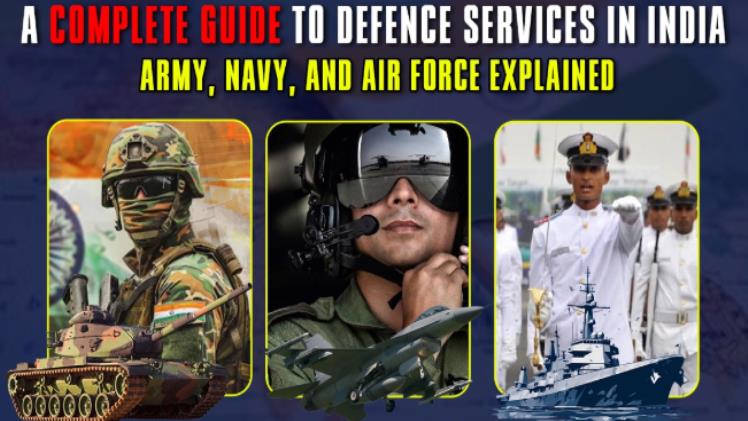A Complete Guide to Defence Services in India: Army, Navy, and Air Force Explained
India’s defence services are among the most respected and powerful forces in the world. They are not just about uniforms, ranks, and battles — they represent courage, commitment, and a lifelong dedication to the nation. Every year, thousands of young aspirants dream of serving in the Indian Armed Forces through prestigious entries like NDA, CDS, and AFCAT.
If you’re planning to begin this journey, understanding the structure and roles of the Indian Army, Navy, and Air Force is the first step. Let’s explore what makes each service unique and how you can prepare to join them.
1. The Indian Army – Strength and Service Beyond Self
Overview
The Indian Army is the largest component of the Indian Armed Forces. It is responsible for maintaining peace, security, and defending the nation’s borders from external and internal threats. Its motto, “Service Before Self,” defines the spirit of every soldier.
Key Responsibilities
- Protecting the nation’s borders on land.
- Conducting rescue operations during natural disasters.
- Participating in peacekeeping missions worldwide under the UN.
- Ensuring internal security and assisting civil authorities when needed.
Structure
The Indian Army is divided into:
- Combat Arms – Infantry, Armoured Corps, Artillery.
- Combat Support Arms – Engineers, Signals, Air Defence.
- Services – Medical Corps, Ordnance, Supply, Education, and Intelligence units.
Training and Life
Training in the Army focuses on discipline, leadership, physical fitness, and tactical excellence. Officers are trained at prestigious institutions like the National Defence Academy (NDA) and the Indian Military Academy (IMA), Dehradun.
2. The Indian Navy – Guardians of the Sea
Overview
The Indian Navy safeguards India’s maritime interests and ensures the security of its coastline, ports, and trade routes. The Navy’s motto, “Sham No Varunah” (May the Lord of the Water be Auspicious Unto Us), signifies its deep-rooted connection with the sea.
Key Responsibilities
- Securing maritime borders and maintaining naval dominance in the Indian Ocean.
- Providing humanitarian aid and disaster relief during emergencies.
- Promoting maritime diplomacy and international cooperation.
- Conducting strategic surveillance and anti-piracy operations.
Major Commands
- Western Naval Command (Mumbai)
- Eastern Naval Command (Visakhapatnam)
- Southern Naval Command (Kochi)
Life in the Navy
A career in the Navy offers adventure, travel, and the opportunity to work with advanced technology like submarines, aircraft carriers, and warships. Naval officers undergo training at institutions like the Indian Naval Academy (INA), Ezhimala.
3. The Indian Air Force – Touching the Sky with Glory
Overview
The Indian Air Force (IAF) is known for its speed, precision, and technological strength. With its motto, “Touch the Sky with Glory,” the IAF is responsible for protecting Indian airspace and ensuring aerial supremacy.
Key Responsibilities
- Defending the nation from aerial threats.
- Conducting air strikes, reconnaissance, and aerial logistics.
- Providing support during natural calamities and humanitarian missions.
- Participating in international exercises to strengthen global defence ties.
Branches of the IAF
- Flying Branch – Pilots and navigators.
- Technical Branch – Engineers maintaining aircraft and systems.
- Ground Duty Branch – Administration, logistics, accounts, and education.
Training and Lifestyle
Life in the IAF is dynamic and demanding. Training takes place at the Air Force Academy (AFA), Dundigal, and focuses on technology, leadership, and discipline.
4. Entry Routes into the Indian Armed Forces
There are several entry pathways to join the defence services, depending on your qualification and age:
- NDA (National Defence Academy) – For students after Class 12th.
- CDS (Combined Defence Services) – For graduates.
- AFCAT (Air Force Common Admission Test) – For Air Force aspirants.
- Technical Entries – For engineering graduates.
Among these, the NDA Exam is one of the most popular and challenging routes, as it allows young candidates to join the Army, Navy, or Air Force after completing their schooling.
5. Preparing for NDA – The Gateway to a Defence Career
Cracking the NDA exam requires more than just academic excellence — it demands discipline, consistency, and the right guidance. Many aspirants seek professional coaching to improve their chances, and Dehradun has emerged as one of the top destinations for NDA preparation.
The Indian Defence Academy (IDA), Dehradun, is widely regarded as one of the best NDA coaching in India. Known for its experienced faculty, structured curriculum, and focus on both written and SSB interview preparation, IDA Dehradun has helped numerous students turn their dreams into reality.
What sets IDA apart is its residential training environment, mentorship programs, and emphasis on overall personality development — essential qualities for a successful defence officer. This makes it one of the best NDA coaching in Dehradun for aspirants who wish to train with discipline and dedication.
6. Life After Joining the Defence Forces
Once you join the Army, Navy, or Air Force, life transforms completely. You develop:
- Leadership skills and decision-making ability.
- Physical and mental resilience.
- Patriotism and teamwork.
- A strong sense of duty, honour, and integrity.
Serving in the Indian Armed Forces is not just a profession — it’s a lifelong commitment to the nation.
7. Final Thoughts
The Indian Armed Forces stand as a symbol of honour, sacrifice, and excellence. Whether you aim to march with the Army, sail with the Navy, or soar with the Air Force, every path leads to serving the nation with pride.
Institutions like the Indian Defence Academy Dehradun are shaping the next generation of defence leaders by providing the right blend of education, discipline, and training. If your goal is to wear the uniform, start early, stay motivated, and give your 100% — because serving India is the highest honour of all.







